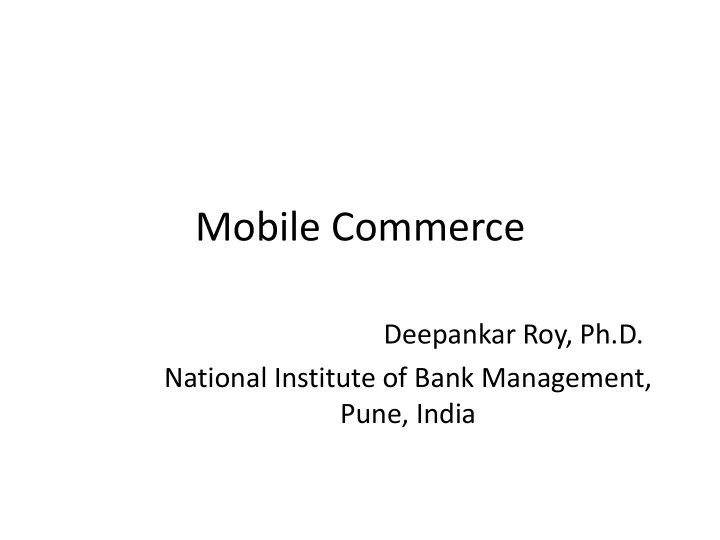

Mobile Commerce Deepankar Roy, Ph.D. National Institute of Bank Management, Pune, India
Outline • What is mobile commerce? • What are the different ways through which mobile commerce happens? • Mobile Commerce examples in India
• Mobile commerce is using mobile phone to buy digital or physical goods and services, remotely from a website or in proximity like a shop, metro station or vending machine. • It can happen through the following 3 ways : 1. Direct carrier billing, where purchase of e.g. digital content like ringtones is charged to a mobile phone bill and that bill is paid by a traditional payment method like credit transfer or direct debit; 2. Mobile point of sale, where a card reader is attached to a mobile phone or tablet to swipe a credit card. Whilst it has the potential to significantly increase the number of points of sale, the resulting payment is a traditional credit card transaction; 3. Mobile product scanning, where a mobile phone is used to scan a product’s bar code at an Apple store for example and links it to customer’s iTunes account. In that case, iTunes bill is settled by a credit card payment.
NFC Payments: Technology Model • Two-way contactless communication over short distance (few centimetres), between NFC enabled phone and reader (e.g. POS terminal or smart poster) • To enable a phone: 1) embed NFC chip, 2) glue NFC sticker at back, 3) insert Micro SD card (for iPhone) • NFC itself does not make a payment, still need to load virtual credit card(s) on phone. • NFC-enabled phones to grow from 7 million in 2011 to 203 million in 2015 (Yankee Group), • More in developed markets as emerging markets generally have basic handsets.
NFC Payments • Used in Japan: 65 million enabled handsets,15 million customers initiating 30-50 million transactions/month with 750,000 merchants • Google Wallet is one example • Consumer and e-commerce companies are better placed than banks to develop these solutions since they own the product : browse the web to find and compare products, locate a store nearby, select the product from a smart poster, receive a discount, and pay for it –all with a mobile phone • Several telecom companies have started mobile wallet initiatives • Handset manufacturers may play a leading role by embedding their NFC chip in the phone
NFC Payments: Issues • There are concerns about security: one must make sure that account and credit card details will be safe if the mobile phone is lost or stolen • There is a high degree of technology evolution: where, for example, does the secure element sit to NFC-enable the handset and store the financial application? • A whole new business has emerged for banks to distribute their payment and credit card services over the air onto the mobile phone via a Trusted Service Manager
Mobile Commerce examples in India a) Mobile Application Service Provider – Paymate Developed a secure online payment system based on Interactive • Voice Response (IVR) system. It has partnered with some Indian banks (e.g. Standard Chartered • Bank of India, State Bank of India) to provide an M-payment service using SMS. The transaction platform links the user’s phone to a bank account, a • credit card or a prepaid account. By entering a PIN code, transactions like retail payments, online • payments and bill payments can be done very easily. For performing the transactions, money can be withdrawn from • different bank accounts, which are registered by the user. “Paymate” has an ecosystem of over 15,000 merchants offering • mobile payments to their customers. It also allows workers in cities to send remittances to their homes • in the villages
Paymate Transaction Process Source : (Bellens, Fuldner & Yip, 2009)
Mobile Commerce examples in India b) IDBI Bank • Bank launched the mobile payment service in Dec 2008 in association with PayMate, one of the leading m- commerce players in the country. • Bank has launched complaints through SMS facility wherein a customer just needs to type “IDBI CARE” and the customer receives a call from the customer care to address his / her grievances. • Customers can use their mobile phones to pay for utility bills, movie and air / railway tickets, restaurant bills, online purchases, mobile recharge, and retail shopping at over 15,000 merchants in India registered with Paymate.
Mobile Commerce examples in India c) Axis Bank • Axis Shop on ngpay: Shop on India's largest mobile mall using Axis Bank account • What is ngpay? – It is a secure and convenient GPRS based mobile application. – ngpay is India's largest mall - located entirely on the customer’s mobile phone. – The customers can use ngpay to buy and shop with over 100 merchants who are on board so far
Axis Bank • Services Available: • Entertainment: Book movie tickets at Fame Cinemas, INOX, PVR, Big Cinema etc. • Travel: Instant booking options at IRCTC, Make-My-Trip, redBus etc. • Shopping: Browse and shop at Landmark, Ferns N Petals, Archies, many more. • Bill Payment: Pay telephone, electricity, insurance premiums etc • Charity: Contribute to charity(CRY, PETA, etc.)
Axis Bank
Axis Bank
Mobile Commerce examples in India d) IMPS Merchant Payments This product is developed by National Payments Corporation of India
IMPS Merchant Payments
IMPS Merchant Payments
IMPS Merchant Payments
Recommend
More recommend